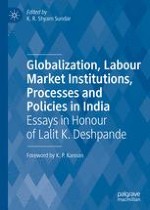2019 | OriginalPaper | Chapter
18. The Dynamic Nature of Jobless Growth in India
Author : Vinoj Abraham
Published in: Globalization, Labour Market Institutions, Processes and Policies in India
Publisher: Springer Nature Singapore
Activate our intelligent search to find suitable subject content or patents.
Select sections of text to find matching patents with Artificial Intelligence. powered by
Select sections of text to find additional relevant content using AI-assisted search. powered by
